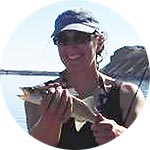What happens if invasive mussels are found in Flaming Gorge?
Review the Rapid Response Plan, and share your input.
By Trina Hedrick
DWR Northeast Region aquatics manager
The 2012 discovery of adult quagga mussels in Lake Powell has heightened our concern for other reservoirs around our state — especially large reservoirs visited often by boaters. In response, the local, state and federal agencies that help manage Flaming Gorge Reservoir (FGR) have coordinated in advance of a positive quagga detection (hopefully we never have one there!) to expedite containment actions that will protect our other regional and state waters if a positive finding were ever to occur in FGR.
The Rapid Response and Control Plan lays out actions that agencies will take before mussels are found (and immediately upon detection) in a waterbody to improve reaction time. Below are the main points from this document.
You can download the entire document. PDF
We are asking you, concerned water users, to review these points and provide us with feedback, knowing that we will be moving forward on this document. Our ability to respond to some comments may be limited as we are required to contain quagga and zebra mussels upon detection at a water in the state; however, we can't think of everything and there may be some great ideas out there that we haven't considered.
Please review these points and let us know what you think, even if it's to say you agree or disagree with our approach. Again, we are required by law to contain infestations so we may not respond to your comment how you'd like, but we will read through them all and would very much appreciate your feedback.
Flaming Gorge Reservoir Rapid Response Summary
- This document represents a collaborative effort between the US Forest Service (USFS), Bureau of Reclamation (BOR), Wyoming Game and Fish Department (WGFD), and the Utah Division of Wildlife Resources (DWR).
- Prevention remains the first priority for addressing the risks of quagga and zebra (collectively known as Dreissenid) mussels.
- In the event that evidence of Dreissenid mussels has been confirmed, management focus will shift from prevention to containment to prevent further spread of invasive mussels
- The purpose of the plan is to expedite the process and act as the guiding document for initial decision making if Dreissenid mussels are confirmed. The steps outlined in the plan will help prevent the further spread of invasive mussels, but will also facilitate effective communication to the boating community on developments around the reservoir.
If Dreissenid mussels are confirmed, the following may occur:
(1) Temporary closure order: Under authority of Utah Rule R657-60-8, the Response Team will pursue the closure of the reservoir until the Control Plan has been implemented. During a closure order, boat access to the reservoir will be temporarily restricted. This temporary closure may last up to five weeks while the following are occurring (see below):
- Threat assessment and extent of colonization: Determining the threat and the extent of the colonization will take approximately three to four weeks to complete.
- Signage installation: Installation of all signs warning of the Dreissenid threat may take up to two weeks to complete.
- Boat ramp closures: Closure of ramps that do not have inspection stations, and closure of all shoreline launching may take one to four weeks.
- Inspection and decontamination stations: Establishment of inspection/decontamination stations at designated boat ramps will take approximately two to five weeks.
Note: these processes are not cumulative. They will take place as needed and may be implemented simultaneously.
(2) Partial closure of reservoir: Once the Control Plan has been implemented and the threat assessed, the temporary closure order will be lifted, and a partial closure of the reservoir may then ensue:
- Only selected high-use developed ramps will likely remain open; for example in Wyoming, Firehole Canyon, Anvil Draw, Buckboard Marina, and/or Brinegar Ferry Crossing would likely remain open, depending on available personnel; in Utah, Lucerne Valley Marina, Sheep Creek Bay, Cedar Springs Marina, and Mustang Ridge would likely remain open.
- Launching at developed launch ramps may be restricted to the dates and times of highest usage and may be dependent on staffing availability. The Response Team, consisting of personnel from DWR, WGFD, USFS and BOR will provide updated information on their webpages, Facebook pages, and other media.
- Highway checkpoints may be established to conduct watercraft inspection and decontamination operations for boats exiting the area. Highway inspection and decontamination stations can take six months to a year to be completed and functional.
- Inspection stations may be established within launch areas for the purpose of inspecting and decontaminating exiting watercraft.
The precautions and steps listed above, while helping to prevent the spread of invasive mussels, will also minimize waiting times for boaters ready to launch or exit the area, reduce confusion regarding both Utah and Wyoming AIS laws and aid boaters in complying with those laws.
Please use the comment feature on the blog post to share feedback. Thank you for the input!















